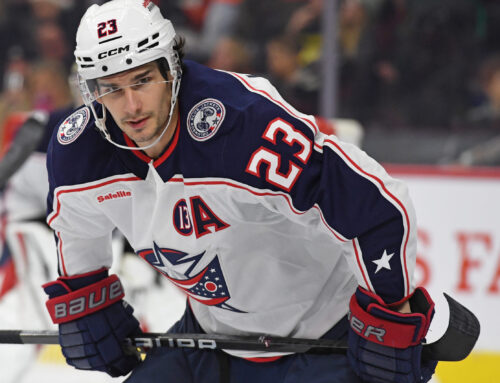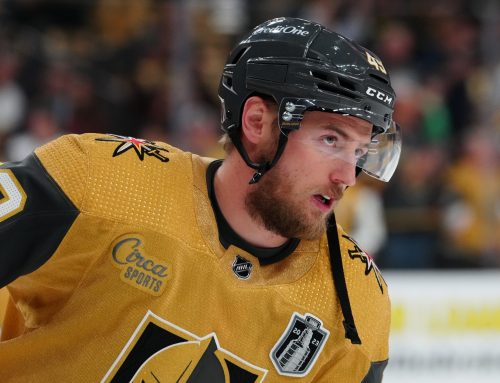In Part 2 of our little power-play suite, we are going to move on from defensemen specifically to production in general. Last week was devoted to opportunity, using things like percent of a team's total power-play, but this week we are focusing on point production and will see who is really taking advantage of their time on the power-play.
To do this we will be using the Big Board Report to get general information on player's points to date, point pace, power-play production and usage. Once we have highlighted a few players we will be using their Player Profile pages to look at personal history and see if we can add any additional context to their current production.
To start we are going to look at the percent of a player's production that has come on the power-play. That will help us isolate player's whose general point totals are seeing an outsized influence from the power-play.
| Name | Pos | Team | GP | PTS | 82GP Pace | PPP | % of PTS on PP | PPTOI | %PP |
| TYSON BARRIE | D | EDM | 30 | 21 | 57 | 14 | 66.67% | 3:12 | 62.3 |
| BRAD MARCHAND | L | BOS | 20 | 21 | 86 | 14 | 66.67% | 3:57 | 70.6 |
| CALE MAKAR | D | COL | 27 | 25 | 76 | 15 | 60.00% | 4:24 | 76 |
| ARTTURI LEHKONEN | L | COL | 24 | 20 | 68 | 12 | 60.00% | 4:17 | 73.8 |
| ALEX DEBRINCAT | L | OTT | 29 | 27 | 76 | 16 | 59.26% | 4:29 | 71.4 |
| AARON EKBLAD | D | FLA | 19 | 12 | 52 | 7 | 58.33% | 3:49 | 63 |
| PATRICK KANE | R | CHI | 27 | 21 | 64 | 12 | 57.14% | 3:47 | 74.4 |
| MATT BOLDY | R | MIN | 29 | 21 | 59 | 12 | 57.14% | 3:48 | 73 |
| VINCENT TROCHECK | C | NYR | 30 | 20 | 55 | 11 | 55.00% | 4:02 | 76.4 |
| RASMUS DAHLIN | D | BUF | 28 | 33 | 97 | 18 | 54.55% | 4:23 | 69.6 |
Given that they are power-play monsters, I expected to be finally able to reference Connor McDavid and Leon Draisaitl here. They are leading the league in power-play points, but are also leading the league in general point production so actually fall just under a 50 percent marker on this stat. Kirill Kaprizov is in a similar boat, and also someone I expected to be referencing here.
It isn't too surprising to see four defensemen represented here. D in general score fewer points, and those on effective power plays will likely see a high percentage of their points be power-play points. That general story line seems to make sense for Tyson Barrie, Cale Makar, and Aaron Ekblad. Rasmus Dahlin might have been the odd ball here preseason, but Tage Thompson's emergence and Buffalo's general production overall this season make it less of a surprise.
I wanted to briefly touch on two interesting if unsurprising players in Brad Marchand and Patrick Kane. Both entered the season with question marks, Marchand with an injury concern, and Kane with the black hole that is the Chicago team. Both are also getting up there in age. Both should though be relied on heavily on their team's top power-play.
Marchand is on pace for his lowest overall point production since 2015-16. On the power-play though there is a lot to like. His general usage (time on ice, percent of the team's power-play) remains essentially the same as in past years and his general involvement in production remains consistent. He has 14 power-play points though in 20 games which is something like a 57-point full-season pace. He has clearly been feasting on the power-play. It sort of buried the lede here, but that means his even strength production has been pretty poor. We won't go too much into it since the focus is power-play production here, but there are some underlying numbers indicating that he should be getting a little better at even strength, which should help make up for it when the power-play points slow down a bit.
Patrick Kane is in a very similar boat. His even strength production is down, while the power-play production is a little elevated (less elevated than Marchand's). Like Marchand his deployment, and participation on the power-play look pretty good, though the power-play's effectiveness overall might dip a little. It is his even strength numbers that are taking a hit (which makes complete sense given the team around him and his age). He does deserve a bit better though and it wouldn't be surprising for both him and Marchand to end up around a point-per game.
Alex DeBrincat was supposed to be Kane's running mate, but given Chicago's woes leaving might have been a good thing for him. Given he is on a new team the first question has to be deployment, but fortunately DeBrincat has been given a similar (and good) opportunity thus far in Ottawa. He is matching the percent of team power-play opportunity this season, but actually seeing slightly more minutes overall on the power-play in Ottawa. He is also participating in a similar amount of the points scored. The production from that unit has him pacing a little high for a season total, so that might slow down a little going forward, but all signs seem good thus far.
Vincent Trocheck also moved teams, so it is definitely worth checking in on him as well. His most successful seasons are when he has full access to a top power-play unit. In those seasons he produced at a 75-point full season pace, but he is on this list producing only at a 55-point pace. We see good power-play deployment (76% of the team's time), and averaging over four minutes a night. It has resulted in 11 power-play points in 30 games, which if maintained would give him career high power-play points. That seems to be working for him, but this career high power-play point pace still leaves him on only a 55-point pace. There is certainly a bit of concern here if career high power-play point production is leading only to a 55 point pace. If that starts to slip before something changes at even strength, we could see a rough stretch for Trocheck.
On the flip side who are the players not taking advantage of their power-play role? The following list is players who are on at least a 70-point pace, getting at least 60 percent of their team's power-play time (so likely on the top unit), but have a very small percentage of their total points coming from the power-play.
| Name | Pos | Team | GP | PTS | 82GP Pace | PPP | % of PTS on PP | PPTOI | %PP |
| PATRIK LAINE | R | CBJ | 15 | 13 | 71 | 2 | 15.38% | 3:47 | 68.1 |
| SIDNEY CROSBY | C | PIT | 29 | 38 | 107 | 7 | 18.42% | 3:51 | 69.5 |
| COLE CAUFIELD | L | MTL | 29 | 25 | 71 | 5 | 20.00% | 3:19 | 61 |
| JAKE GUENTZEL | L | PIT | 25 | 29 | 95 | 6 | 20.69% | 3:31 | 66.5 |
| SEBASTIAN AHO | C | CAR | 26 | 27 | 85 | 6 | 22.22% | 3:42 | 63.7 |
| TROY TERRY | R | ANA | 30 | 27 | 74 | 6 | 22.22% | 2:53 | 62.9 |
| JOHNNY GAUDREAU | L | CBJ | 28 | 31 | 91 | 7 | 22.58% | 3:09 | 71.8 |
| TOMAS HERTL | C | S.J | 31 | 30 | 79 | 7 | 23.33% | 2:55 | 69.4 |
| ERIK KARLSSON | D | S.J | 31 | 38 | 101 | 9 | 23.68% | 3:07 | 74.1 |
| NICO HISCHIER | C | N.J | 28 | 29 | 85 | 7 | 24.14% | 3:20 | 65.8 |
Sticking with the over-the-hill theme, Sidney Crosby's 107-point pace is a bit of a marvel. At 35 he is on pace for his most productive season since 2015-16. Given he is on this list, that means he isn't even doing it on the power-play. In fact, his current power-play production is essentially the lowest of his career. A part of that is definitely a low power-play IPP meaning that he isn't getting in on as many of the power-play's goals as he should.
Someone Erik Karlsson's resurgent 101-point pace only contains nine power-play points. That means 29 even strength points in 31 games. He is currently pacing for 23 power-play points, while his usage is much closer to his usage from his Ottawa days where he was producing 30 power-play points in any given season. So sure, his even strength production is a bit steep. Both is team and personal shooting percentages are too high, but he is likely due some more power-play production that might help lessen the regression.
That is all for this week
Do your part to support organizations working to make hockey for everyone.






 ANA
ANA UTA
UTA MIN
MIN CAR
CAR MTL
MTL NYI
NYI VGK
VGK DET
DET
